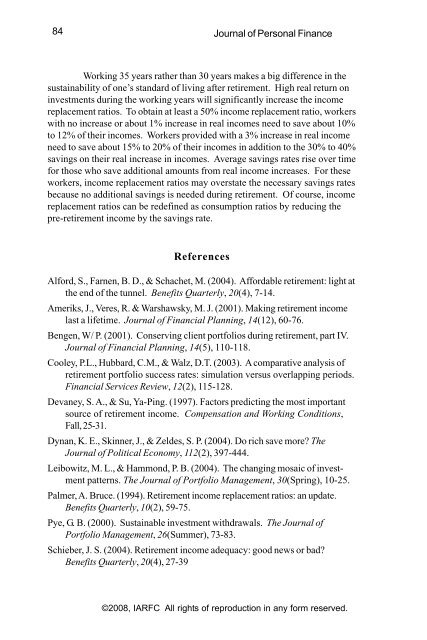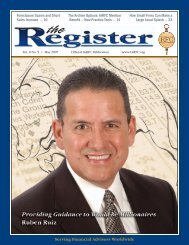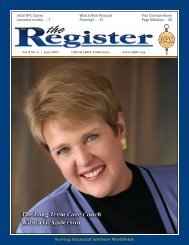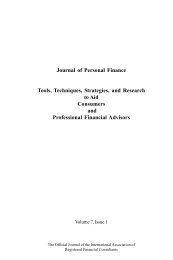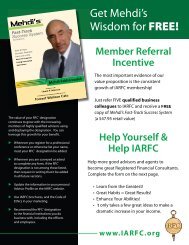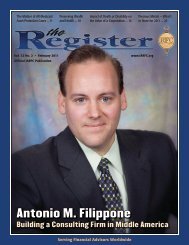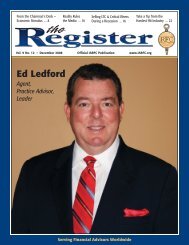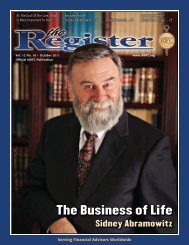3433-vol. 6 issue 2-3.pmd - iarfc
3433-vol. 6 issue 2-3.pmd - iarfc
3433-vol. 6 issue 2-3.pmd - iarfc
You also want an ePaper? Increase the reach of your titles
YUMPU automatically turns print PDFs into web optimized ePapers that Google loves.
84<br />
Journal of Personal Finance<br />
Working 35 years rather than 30 years makes a big difference in the<br />
sustainability of one’s standard of living after retirement. High real return on<br />
investments during the working years will significantly increase the income<br />
replacement ratios. To obtain at least a 50% income replacement ratio, workers<br />
with no increase or about 1% increase in real incomes need to save about 10%<br />
to 12% of their incomes. Workers provided with a 3% increase in real income<br />
need to save about 15% to 20% of their incomes in addition to the 30% to 40%<br />
savings on their real increase in incomes. Average savings rates rise over time<br />
for those who save additional amounts from real income increases. For these<br />
workers, income replacement ratios may overstate the necessary savings rates<br />
because no additional savings is needed during retirement. Of course, income<br />
replacement ratios can be redefined as consumption ratios by reducing the<br />
pre-retirement income by the savings rate.<br />
References<br />
Alford, S., Farnen, B. D., & Schachet, M. (2004). Affordable retirement: light at<br />
the end of the tunnel. Benefits Quarterly, 20(4), 7-14.<br />
Ameriks, J., Veres, R. & Warshawsky, M. J. (2001). Making retirement income<br />
last a lifetime. Journal of Financial Planning, 14(12), 60-76.<br />
Bengen, W/ P. (2001). Conserving client portfolios during retirement, part IV.<br />
Journal of Financial Planning, 14(5), 110-118.<br />
Cooley, P.L., Hubbard, C.M., & Walz, D.T. (2003). A comparative analysis of<br />
retirement portfolio success rates: simulation versus overlapping periods.<br />
Financial Services Review, 12(2), 115-128.<br />
Devaney, S. A., & Su, Ya-Ping. (1997). Factors predicting the most important<br />
source of retirement income. Compensation and Working Conditions,<br />
Fall, 25-31.<br />
Dynan, K. E., Skinner, J., & Zeldes, S. P. (2004). Do rich save more? The<br />
Journal of Political Economy, 112(2), 397-444.<br />
Leibowitz, M. L., & Hammond, P. B. (2004). The changing mosaic of investment<br />
patterns. The Journal of Portfolio Management, 30(Spring), 10-25.<br />
Palmer, A. Bruce. (1994). Retirement income replacement ratios: an update.<br />
Benefits Quarterly, 10(2), 59-75.<br />
Pye, G. B. (2000). Sustainable investment withdrawals. The Journal of<br />
Portfolio Management, 26(Summer), 73-83.<br />
Schieber, J. S. (2004). Retirement income adequacy: good news or bad?<br />
Benefits Quarterly, 20(4), 27-39<br />
©2008, IARFC All rights of reproduction in any form reserved.


